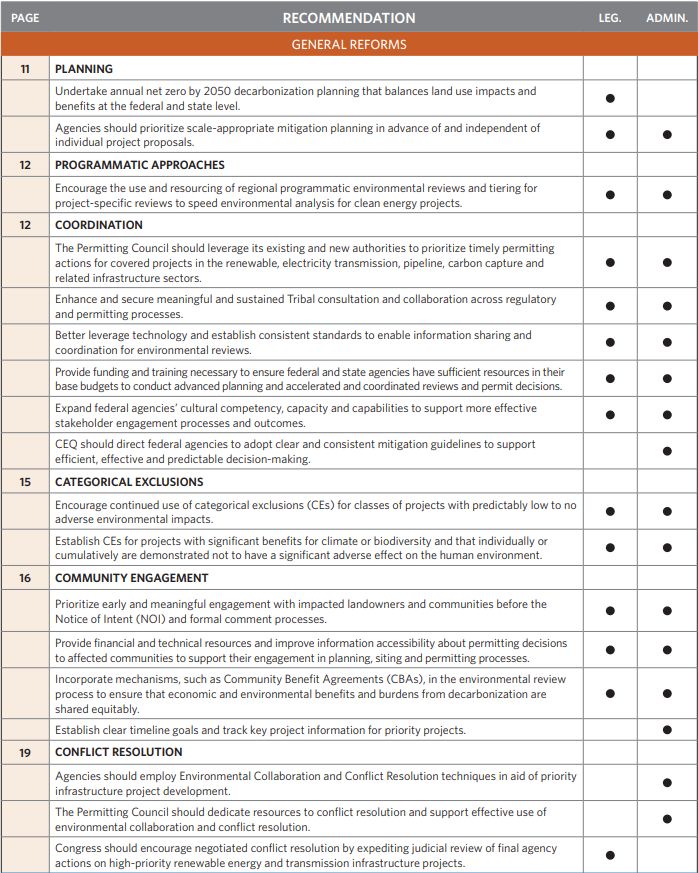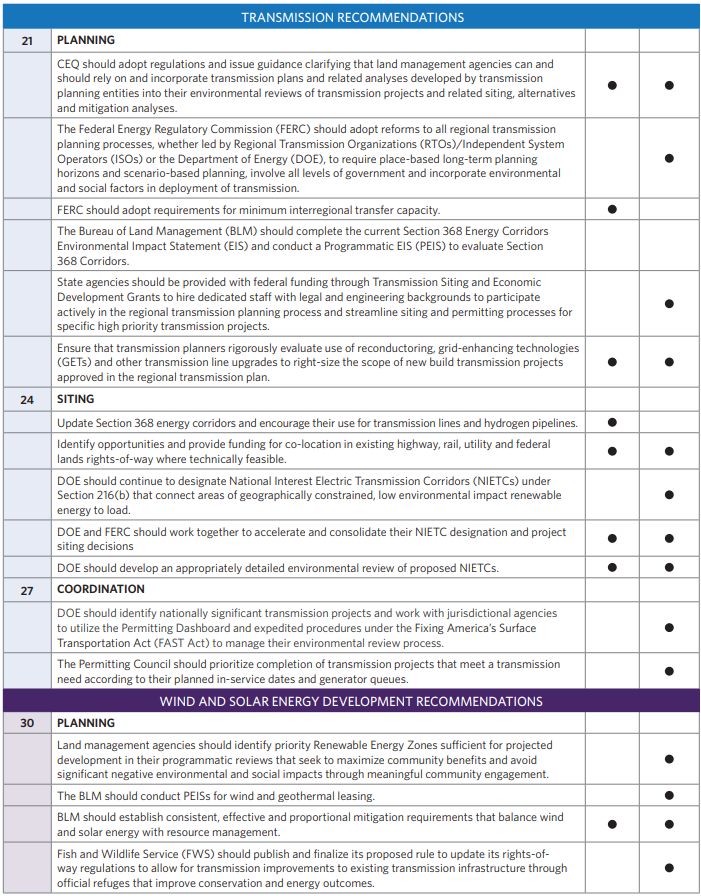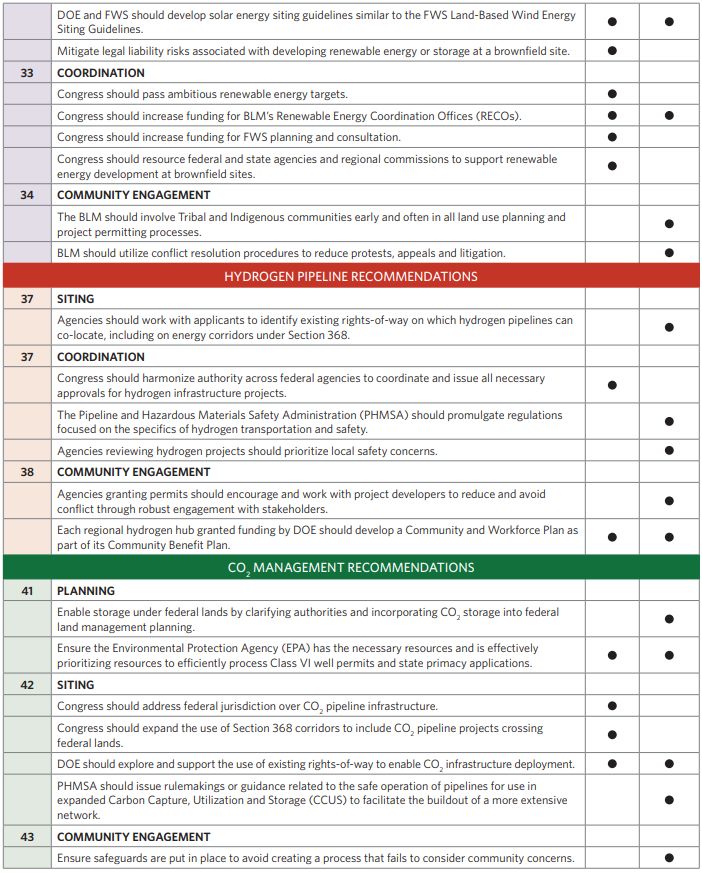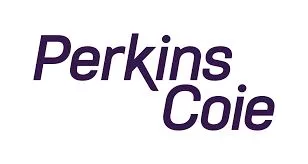- with readers working within the Utilities industries
- within Family and Matrimonial, Transport and Real Estate and Construction topic(s)
About This Report
This reports offers recommendations for legislative and administrative reforms to improve the environmental permitting process, as well as providing background and context on applicable statutory and regulatory frameworks. It is based on the current state of environmental permitting practice, and is intended as a starting point for ongoing and evolving policy conversations on environmental permitting modernization. This report includes input from numerous subject matter experts at The Nature Conservancy across multiple geographies and subject matter areas, with acknowledgement to Jason Albritton, Laura Brannen, Peter Gower, Paul Heberling, Nels Johnson, Brent Keith, Melanie Santiago-Mosier, Cody Sullivan and Jessica Wilkinson. The report was developed in partnership with Perkins Coie LLP, with thanks to Ted Boling, Laura Morton, Jane Rueger and Kerensa Gimre for their support and expertise.
Special thanks to Resource Media and Hoffman Design Group for support with copyediting and design.
About The Nature Conservancy
The Nature Conservancy is a global conservation organization dedicated to conserving the lands and waters on which all life depends. Guided by science, we create innovative, on-the-ground solutions to our world's toughest challenges so that nature and people can thrive together. We are tackling climate change, conserving lands, waters and oceans at an unprecedented scale, providing food and water sustainably and helping make cities more sustainable. The Nature Conservancy is working to make a lasting difference around the world in 77 countries and territories through a collaborative approach that engages local communities, governments, the private sector and other partners. Cover Photo © Stuart Palley | Solar panels and turbines in California. April, 2021.
Executive Summary
The United States must take concrete actions now to enable a clean energy and nature-positive future. This requires ambitious emissions reductions, while protecting and restoring sensitive natural and working lands and maximizing benefits for communities. To avoid the worst impacts of a warming climate, the nation must rapidly transition to clean energy, which will necessitate a 400 percent increase in renewable energy by 20501 and at least a 2.5 times expansion of inter-regional transmission.2 Reaching the pace and scale the moment demands will require reforming and modernizing key permitting and approval processes at all levels of government and a host of complementary actions to accelerate climate mitigation and restoration projects. The Nature Conservancy's (TNC) goal is to facilitate the delivery of critical clean energy resources, related infrastructure and ecosystem restoration projects at least 50 percent faster than they are today
THE CHALLENGE
Recent passage of landmark climate and infrastructure legislation in the U.S. offers a once-in-a-lifetime opportunity to accelerate the transition to clean energy and slash greenhouse gas (GHG) emissions. However, the process for approving clean energy generation, transmission and other infrastructure in the U.S. is complex, with all levels of government playing critical roles. This can result in long timelines for reviews and approvals and many projects never make it to construction. Project delays and cancellations account for potential lost solar and wind generating capacity of at least 4.6 gigawatts (GW) annually.3 Currently, there are sufficient clean energy projects planned and seeking interconnection to supply 90 percent of U.S. electricity needs from zero-carbon resources by 2035.4 Nonetheless, if the past is a predictor of the future, only some of these wind, solar and storage projects are likely to be built. For many renewable energy generation projects, the time to completion is rising—from about two years in 2000-2007 to almost four years for those built since 2018. Approval times for major transmission projects can run even longer to over a decade, yet such projects are critical for connecting new zero-emitting generation to demand centers.5
At the same time, these permitting and approval processes provide important safeguards by addressing conservation, public engagement, safety and economic goals, especially in ecologically sensitive areas or already overburdened communities. The environmental permitting and review process provides critical venues for potentially affected communities to learn about and influence projects; structures for agency experts to collaborate; platforms for providing decision-makers with analysis; vehicles for designing and enforcing mitigation measures; and more. Finding innovative ways to accelerate the permitting and approval process for clean energy infrastructure projects while preserving the benefits of the permitting and approval process is critical not only for getting us to a clean and equitable energy future, but also to realize recent legislation's full potential.
THE PATH FORWARD
There are multiple barriers to successful development of major infrastructure projects for climate mitigation and adaptation, including market design inefficiencies, project review and permitting delays, supply chain constraints and local opposition. Although all of these challenges must be addressed, improving how we design, permit and approve projects can remove barriers and accelerate project delivery. Reforms should:
- Target bottlenecks that slow projects that provide meaningful emission reductions;
- Balance climate, conservation and community concerns to reduce conflicts and accelerate project delivery;
- Avoid and minimize impacts to natural and working lands and local communities;
- Encourage planning processes to identify projects to prioritize for review and permitting; and
- Provide tangible and equitable benefits for impacted communities and allow for robust and early community engagement.
This report offers a series of federal administrative and legislative recommendations to reform permitting and project approval processes for major infrastructure and clean energy projects. These reforms are designed to increase the efficiency and certainty of permitting and review for clean energy projects and related infrastructure while protecting the conservation and community engagement goals of the permitting process. The report outlines general reforms to increase transparency, improve planning and siting, employ programmatic approaches, efficiently resolve conflicts and better engage and share benefits with communities to accelerate the clean energy transition. The report also includes recommendations specifically for the sectors of electric transmission, solar and wind energy, hydrogen pipelines and carbon dioxide (CO2 ) management. These recommendations are based on the current permitting reform landscape. As new information, practices and legislative and regulatory changes continue to develop, TNC may develop further recommendations in the future. The report appendices provide background on recent federal administrative actions and initiatives directed at improving permitting and review processes and summarize key federal statutory authorities affecting permitting and approvals of clean energy projects and related infrastructure.
Common themes highlighted throughout the recommendations include:
- Agencies and states should undertake planning to identify projects that are most critical for meeting climate goals, that minimize impacts to conservation and that maximize benefits to communities. Agencies should leverage these planning products to prioritize identified projects for approval and interconnection, reducing timelines and duplication in subsequent permitting and review.
- The Permitting Council should prioritize climate mitigation and adaptation projects with agency leadership focused on improving the efficiency of informed decision-making, collaboration and dispute resolution to expedite decisions.
- Meaningful, early engagement with affected communities must be a part of all planning processes and project approvals to ensure respect of sovereign rights, alignment on priorities and equitable benefits sharing and to avoid conflict and reduce delays.
- Sustained and meaningful Tribal consultation and collaboration across regulatory and permitting processes should be enhanced and secured as the foundation for building ongoing partnerships that uplift Tribal perspectives and authority, avoid conflicts and reduce delays.
- Conflicts should be resolved fairly and expeditiously, and when collaboration does not resolve conflicts, challenges to project decisions should be evaluated and resolved in an expedited, transparent and predictable manner.
- Funding and staffing of permitting agencies should be prioritized, with agencies at all levels receiving adequate resources and training to enable rapid and efficient environmental review and authorization decisions.
- Federal agencies, led by the White House Council on Environmental Quality (CEQ), must ensure consistency in agency terminology, methodologies and standards for evaluation of impacts, alternatives, mitigation and environmental costs and benefits, as well as drive improved inter-agency coordination and incorporation of existing information into environmental reviews.
Together, these recommendations would speed deployment of critical clean energy and climate mitigation projects while ensuring robust community input, equitable benefit sharing and minimization of impacts to natural and working lands.
1. Recommendation Summary Table



2. General Reforms to Improve Siting and Permitting of Infrastructure Projects
INTRODUCTION
The transition to a clean energy economy will require deployment of many different types of projects, including wind and solar generation, transmission lines, hydrogen pipelines, CO2 management and others. All these types of projects will have to navigate some form of environmental permitting and review processes. This paper documents opportunities to leverage or create efficiencies in the permitting process that would benefit projects across all sectors.
This section details TNC's recommendations to improve the siting and permitting of infrastructure projects across multiple sectors. These generally applicable recommendations address planning and siting, coordination, transparency, community engagement, conflict resolution and process efficiency. Each recommendation includes background and discussion of the related issue, followed by specific suggested legislative and administrative actions. These recommendations are designed to accelerate deployment of clean energy infrastructure, improve environmental outcomes and facilitate community engagement.
RECOMMENDATIONS
Planning
RECOMMENDATION: Undertake annual net zero by 2050 decarbonization planning that balances land use impacts and benefits at the federal and state level.
Congress should provide funding and direct the DOE and its labs to undertake annual decarbonization plans with the goal of reaching economy-wide, net zero emissions by 2050. Funds should be appropriated to relevant agencies to develop and improve existing spatially explicit natural resource, community and cultural data. Such new and existing data should be integrated into existing electricity system modeling to improve our understanding of and solutions to land use trade-offs. These data should include information on sensitive wildlife habitat and species, priority areas for ensuring resilient and connected landscapes, sensitive working lands and those with high potential for co-benefits, cultural resources and environmental justice communities.
Federal-level analysis could inform state-level decarbonization planning, but state agencies may hold more detailed natural resource, community and cultural data and should be encouraged to pursue their own decarbonization planning to inform state-level policies. Congress and federal agencies could support this state-level analysis by providing incentives, funding and technical assistance.
Legislative: Congress should direct DOE, and incentivize and fund states, to undertake annual net zero by 2050 decarbonization planning that utilizes the best available, high-resolution data on sensitive conservation and community resources.
RECOMMENDATION: Agencies should prioritize scale-appropriate mitigation planning in advance of and independent of individual project proposals.
Habitat fragmentation and loss is a critical limitation to healthy populations of many species and habitat resiliency in the face of a changing climate. Federal lead agencies, particularly those that make significant, foreseeable and incremental investments in large infrastructure projects on public lands, can support improved mitigation and conservation planning in advance of project impacts to provide environmental, cost and time-saving benefits to energy infrastructure siting and mitigation decision-making. These processes should involve early, meaningful and robust Tribal consultation to respect Tribal sovereignty and incorporate their deep knowledge of relevant landscapes in decision-making and planning. Through proper analysis and application of Geographic Information System (GIS) technologies, such as the Climate and Economic Justice Screening Tool (CEJST), potential conflicts in project siting can be avoided or minimized and appropriate means of compensatory mitigation can be considered in advance of formal public processes. Several agencies, such as the Federal Highway Administration (FHWA), have recognized the value of proactively planning projects holistically and have successfully taken advantage of streamlined permitting opportunities. FHWA models and case studies have been captured in the agency's Eco-Logical approach and the Environmental Review Toolkit
Footnotes
1. Larson, E., et al., Net-Zero America: Potential Pathways, Infrastructure, and Impacts. Interim report. (Princeton University, Princeton, NJ, December 2020.
2.The Nature Conservancy. Power of Place: Clean Energy Solutions that Protect People and Nature. (The Nature Conservancy, 2023, May 9). https://www. nature.org/en-us/what-we-do/our-priorities/tackle-climate-change/climate-change-stories/power-of-place
3. Susskind, L., et al., Sources of opposition to renewable energy projects in the United States. (Energy Policy, 2022), 165, 112922.
4. Lawrence Berkeley National Laboratory. Grid connection requests grow by 40% in 2022 as clean energy surges, despite backlogs and uncertainty. (Lawrence Berkeley National Laboratory, 2023, April 6). https://emp.lbl.gov/news/grid-connection-requests-grow-40-2022
5. For example, Princeton University finds that the pace of building new transmission must more than double, or 80 percent of the emissions benefits of the Inflation Reduction Act could be lost Princeton University Zero Lab. Princeton University, REPEAT Team. Electricity Transmission is Key to Unlock the Full Potential of the Inflation Reduction Act. https://repeatproject.org/docs/REPEAT_IRA_Transmission_2022-09-22.pdf
To view the full article click here.
The content of this article is intended to provide a general guide to the subject matter. Specialist advice should be sought about your specific circumstances.





